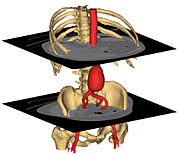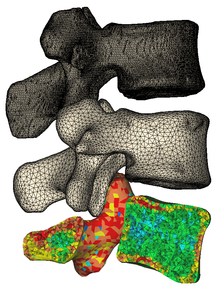- Mimics
-
Mimics 
3D surface models created in Mimics from CTDeveloper(s) Materialise NV Stable release 14.12 Operating system Windows Platform 32/64bit Website Mimics homepage Mimics is an image processing software for 3D design and modeling, developed by Materialise NV[1], a Belgian company specialized in additive manufacturing software and technology. Mimics is used to create 3D surface models from stacks of 2D image data. These 3D models can then be used for a variety of engineering applications. Mimics is an acronym for Materialise Interactive Medical Image Control System. It is developed in an ISO environment with CE and FDA 510k premarket clearance. Mimics is commercially available as part of the Mimics Innovation Suite, which also contains 3-matic, a design and meshing software for anatomical data. The current version is 14.1, it supports Windows 7, Vista and XP in both x32 and x64.
Contents
Process
Mimics calculates surface 3D models from stacked image data such as Computed Tomography (CT), Confocal Microscopy, Micro CT, and Magnetic Resonance Imaging (MRI) through image segmentation. The ROI, selected in the segmentation process is converted to a 3D surface model using an adapted marching cubes algorithm that takes the partial volume effect into account, leading to very accurate 3D models[2][3]. The 3D files are represented in the STL format.
Most common input format is DICOM, but other image formats such as: TIFF, JPEG, BMP and Raw are also supported.
Output file formats differ, depending on the subsequent application: common 3D output formats include STL, VRML, PLY and DXF. The 3D files can also be optimized for FEA or CFD and can therefore be exported to Abaqus in INP format, to Ansys in INP, CDB and MSH format, to Nastran in OUT, NAS and BDF format, and to Comsol in MPHTXT format. To continue with Computer-aided design, the files can be exported in IGES format or as Point cloud.
Industries
Mimics has been adopted by biomedical engineers and device manufacturers for R&D purposes in various medical industries:
- Orthopedic
- Craniomaxillofacial
- Cardiovascular
- Pulmonology
These industries use patient-specific 3D data to improve their implants and devices or to get a better understanding of biomechanical processes. Also non-medical industries like materials science use Mimics in image-based R&D.
Applications
Mimics is a platform to bridge stacked image data to a variety of different medical engineering applications:
- 3D measurements and analyses
- Finite Element Analysis: ABAQUS, ANSYS,...etc
- Computational Fluid Dynamics: FLUENT, CFX,...etc
- Computer Aided Design: SolidWorks, Pro/E...etc
- Rapid Prototyping: 3D Systems, EOS, Stratasys, ZCorp, , Dimension, Objet, ... etc
- Surgical simulation
- Customized implant design
Gallery
See also
References
- ^ www.materialise.com Materialise develops 3D software for the medical, dental and additive manufacturing industries
- ^ Gelaude F, Vander Sloten J, Lauwers B. Accuracy assessment of CT-based outer surface meshes, Computer Aided Surgery 2008, 13(4), p188-199.
- ^ Jamali AA et al. Linear and angular measurements of computer-generated models: are they accurate, valid and reliable? Computer Aided Surgery 2007, 12(5), p278-285.
External links
Categories:- Biomedical engineering
- Windows software
- 3D graphics software
- Computer-aided design software
Wikimedia Foundation. 2010.




